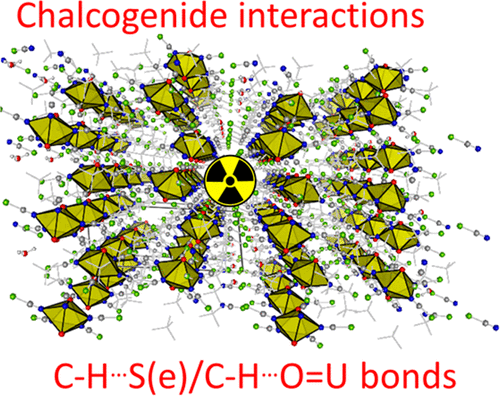当前位置:
X-MOL 学术
›
Inorg. Chem.
›
论文详情
Our official English website, www.x-mol.net, welcomes your
feedback! (Note: you will need to create a separate account there.)
Pseudohalide Tectons within the Coordination Sphere of the Uranyl Ion: Experimental and Theoretical Study of C–H···O, C–H···S, and Chalcogenide Noncovalent Interactions
Inorganic Chemistry ( IF 4.3 ) Pub Date : 2018-03-15 00:00:00 , DOI: 10.1021/acs.inorgchem.7b02967 Stefano Nuzzo 1 , Brendan Twamley 1 , James A. Platts 2 , Robert J. Baker 1
Inorganic Chemistry ( IF 4.3 ) Pub Date : 2018-03-15 00:00:00 , DOI: 10.1021/acs.inorgchem.7b02967 Stefano Nuzzo 1 , Brendan Twamley 1 , James A. Platts 2 , Robert J. Baker 1
Affiliation

|
A series of uranyl thiocyanate and selenocyanate of the type [R4N]3[UO2(NCS)5] (R4 = nBu4, Me3Bz, Et3Bz), [Ph4P][UO2(NCS)3(NO3)] and [R4N]3[UO2(NCSe)5] (R4 = Me4, nPr4, Et3Bz) have been prepared and structurally characterized. The resulting noncovalent interactions have been examined and compared to other examples in the literature. The nature of these interactions is determined by the cation so that when the alkyl groups are small, chalcogenide···chalcogenide interactions are present, but this “switches off” when R = nPr and charge assisted U═O···H–C and S(e)···H–C hydrogen bonding remain the dominant interaction. Increasing the size of the chain to nBu results in only S···H–C interactions. The spectroscopic implications of these chalcogenide interactions have been explored in the vibrational and photophysical properties of the series [R4N]3[UO2(NCS)5] (R4 = Me4, Et4, nPr4, nBu4, Me3Bz, Et3Bz), [R4N]3[UO2(NCSe)5] (R4 = Me4, nPr4, Et3Bz) and [Et4N]4[UO2(NCSe)5][NCSe]. The data suggest that U═O···H–C interactions are weak and do not perturb the uranyl moiety. While the chalcogenide interactions do not influence the photophysical properties, a coupling of the U═O and δ(NCS) or δ(NCSe) vibrational modes is observed in the 77 K solid state emission spectra. A theoretical examination of representative examples of Se···Se, C–H···Se, and C–H···O═U by molecular electrostatic potentials and NBO and AIM methodologies gives a deeper understanding of these weak interactions. C–H···Se are individually weak but C–H···O═U interactions are even weaker, supporting the idea that the -yl oxo’s are weak Lewis bases. An Atoms in Molecules study suggests that the chalcogenide interaction is similar to lone pair···π or fluorine···fluorine interactions. An oxidation of the NCS ligands to form [(UO2)(SO4)2(H2O)4]·3H2O was also noted.
中文翻译:

铀酰离子配位区内的伪卤化物构造子:C–H··O,C–H··S和硫族化物非共价相互作用的实验和理论研究
[R 4 N] 3 [UO 2(NCS)5 ]类型的一系列硫氰酸铀酯和硒代氰酸酯(R 4 = n Bu 4,Me 3 Bz,Et 3 Bz),[Ph 4 P] [UO 2( NCS)3(NO 3)]和[R 4 N] 3 [UO 2(NCSe)5 ](R 4 = Me 4,n Pr 4,Et 3Bz)已经被制备并在结构上被表征。已经检查了所产生的非共价相互作用,并与文献中的其他实例进行了比较。这些相互作用的性质由阳离子决定,因此当烷基基团较小时,会出现硫族化物···硫族化物相互作用,但是当R = n Pr和电荷辅助的U═O···H–时,这种“关断” C和S(e)···H–C氢键仍然是主要相互作用。将链的大小增加到n Bu只会导致S···HC相互作用。这些硫族化物相互作用的光谱学意义已经在[R 4 N] 3 [UO 2(NCS)5 ]系列的振动和光物理性质中进行了探索。](R 4 = Me 4,Et 4,n Pr 4,n Bu 4,Me 3 Bz,Et 3 Bz),[R 4 N] 3 [UO 2(NCSe)5 ](R 4 = Me 4,n Pr 4,Et 3 Bz)和[Et 4 N] 4 [UO 2(NCSe)5] [NCSe]。数据表明,U═O···H–C相互作用较弱,不会干扰铀酰部分。尽管硫族化物相互作用不影响光物理性质,但在77 K固态发射光谱中观察到U═O和δ(NCS)或δ(NCSe)振动模式的耦合。通过分子静电势以及NBO和AIM方法学对Se··Se,CH·H··Se和CH·H··O═U的代表性实例进行理论检验,可以更深入地了解这些弱相互作用。C–H···Se个别弱,但C–H···O═U相互作用更弱,支持以下观点:-yl oxo's是弱的Lewis碱。分子研究表明,硫族化物的相互作用类似于孤对···π或氟···氟的相互作用。NCS配体的氧化形成[(UO 2)(SO 4)2(H 2 O)4 ]·3H 2 O的还指出。
更新日期:2018-03-15
中文翻译:

铀酰离子配位区内的伪卤化物构造子:C–H··O,C–H··S和硫族化物非共价相互作用的实验和理论研究
[R 4 N] 3 [UO 2(NCS)5 ]类型的一系列硫氰酸铀酯和硒代氰酸酯(R 4 = n Bu 4,Me 3 Bz,Et 3 Bz),[Ph 4 P] [UO 2( NCS)3(NO 3)]和[R 4 N] 3 [UO 2(NCSe)5 ](R 4 = Me 4,n Pr 4,Et 3Bz)已经被制备并在结构上被表征。已经检查了所产生的非共价相互作用,并与文献中的其他实例进行了比较。这些相互作用的性质由阳离子决定,因此当烷基基团较小时,会出现硫族化物···硫族化物相互作用,但是当R = n Pr和电荷辅助的U═O···H–时,这种“关断” C和S(e)···H–C氢键仍然是主要相互作用。将链的大小增加到n Bu只会导致S···HC相互作用。这些硫族化物相互作用的光谱学意义已经在[R 4 N] 3 [UO 2(NCS)5 ]系列的振动和光物理性质中进行了探索。](R 4 = Me 4,Et 4,n Pr 4,n Bu 4,Me 3 Bz,Et 3 Bz),[R 4 N] 3 [UO 2(NCSe)5 ](R 4 = Me 4,n Pr 4,Et 3 Bz)和[Et 4 N] 4 [UO 2(NCSe)5] [NCSe]。数据表明,U═O···H–C相互作用较弱,不会干扰铀酰部分。尽管硫族化物相互作用不影响光物理性质,但在77 K固态发射光谱中观察到U═O和δ(NCS)或δ(NCSe)振动模式的耦合。通过分子静电势以及NBO和AIM方法学对Se··Se,CH·H··Se和CH·H··O═U的代表性实例进行理论检验,可以更深入地了解这些弱相互作用。C–H···Se个别弱,但C–H···O═U相互作用更弱,支持以下观点:-yl oxo's是弱的Lewis碱。分子研究表明,硫族化物的相互作用类似于孤对···π或氟···氟的相互作用。NCS配体的氧化形成[(UO 2)(SO 4)2(H 2 O)4 ]·3H 2 O的还指出。











































 京公网安备 11010802027423号
京公网安备 11010802027423号